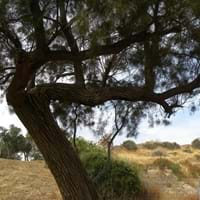Life Span
Perennial
Perennial
Type
Flowering Plants, Fruits, Trees
Tree
Origin
Central America, Europe, North America
Turkey, Iraq, Western Asia, India
Types
Not Available
Tamarix Chinensis, French Tamarisk, Kashgar Tamarix, Tamarix Odessana,
Tamarix Tetrandra
Number of Varieties
Not Available
Habitat
Hedge, Scrubs, Woods
Floodplains, marshes, Riverbanks, Shores of rivers or lakes
USDA Hardiness Zone
4-8
10-13
AHS Heat Zone
Not Available
12-1
Sunset Zone
Not Available
7, 8, 9, 14, 15, 16, 17, 18, 19, 20, 21, 22, 23, 24
Habit
Not Available
Upright/Erect
Flower Color
White
Purple
Flower Color Modifier
Not Available
Bicolor
Fruit Color
Yellow
Not Available
Leaf Color in Spring
Dark Green
Green
Leaf Color in Summer
Green
Green
Leaf Color in Fall
Brown, Green, Light Yellow
Green
Leaf Color in Winter
Not Available
Not Available
Leaf Shape
Oblong
Scale-like imbricate
Plant Season
Summer
Summer
Sunlight
Full Sun, Partial shade
Full Sun
Growth Rate
Medium
Very Fast
Type of Soil
Loamy
Loam, Sand
The pH of Soil
Neutral
Acidic, Neutral, Alkaline
Soil Drainage
Well drained
Well drained
Bloom Time
Fall, Summer
Summer, Late Summer, Early Fall
Tolerances
Drought
Drought and Salt, Heat And Humidity
Where to Plant?
Ground
Ground
How to Plant?
Grafting, Seedlings, Transplanting
Seedlings
Plant Maintenance
Medium
Medium
Watering Requirements
Medium
Average Water Needs
In Summer
Lots of watering
Lots of watering
In Spring
Moderate
Moderate
In Winter
Average Water
Average Water
Soil pH
Neutral
Acidic, Neutral, Alkaline
Soil Type
Loamy
Loam, Sand
Soil Drainage Capacity
Well drained
Well drained
Sun Exposure
Full Sun, Partial shade
Full Sun
Pruning
Prune when plant is dormant, Remove dead or diseased plant parts
Cut leaves after fall, Prune after flowering, Remove damaged leaves, Remove dead branches, Remove dead leaves
Fertilizers
All-Purpose Liquid Fertilizer
All-Purpose Liquid Fertilizer
Pests and Diseases
Aphids, Curculio occidentis, Japanese Beetles, Leaf Rollers, Leafminer, Mites, Red blotch, sawflies, Scale, Stink bugs
Mineral deficiencies, Red blotch, Root knot nematode, Scale, yellow-poplar weevil
Plant Tolerance
Drought
Drought, Dry Conditions, Salt
Flowers
Yes
Not Available
Flower Petal Number
Single
Single
Foliage Texture
Medium
Fine
Foliage Sheen
Matte
Matte
Attracts
Not Available
Not Available
Allergy
Digestive Problems, Respiratory problems
allergic reaction
Aesthetic Uses
Showy Purposes
Ground Cover, Showy Purposes
Beauty Benefits
Beautiful Skin
Not Available
Environmental Uses
Food for birds
Air purification
Medicinal Uses
Anthelmintic, Antibacterial, Astringent, Hypnotic, Laxative, Refrigerant
Diarrhea, Liver problems, Rheumatism, Skin wounds, Tooth ache
Part of Plant Used
Fruits
Sap, Wood
Other Uses
Edible syrup, Jam, Jelly, Used As Food
Traditional medicine, Used as Ornamental plant, Used for its medicinal properties
Used As Indoor Plant
No
No
Used As Outdoor Plant
Yes
Yes
Garden Design
Not Available
Screening / Wind Break
Botanical Name
Malus sylvestris
TAMARIX dioica
Common Name
European crab apple
Dioecious Tamarisk, Tamarisk
In Hindi
european crab apple
तामरिस्क
In German
Der Holzapfel, Europäischer Wildapfel
Tamariske
In French
Le Boquettier, le Pommier sauvage ou Pommier des bois
tamarinier
In Spanish
Malus sylvestris, el Manzano silvestre, manzano silvestre europeo
tamarisco
In Greek
Ευρωπαϊκή μήλο καβουριών
ταμαρίς
In Portuguese
Malus sylvestris
tamarisco
In Polish
Jabłoń dzika
tamaryszek
In Latin
european crab apple
nemore
Phylum
Magnoliophyta
Magnoliophyta
Class
Magnoliopsida
Magnoliopsida
Order
Rosales
Caryophyllales
Family
Rosaceae
Tamaricaceae
Clade
Angiosperms, Eudicots, Rosids
Angiosperms, Core eudicots, Eudicots
Tribe
Not Available
Not Available
Subfamily
Not Available
Not Available
Number of Species
Not Available
Importance of European Crab Apple and Tamarisk
Want to have the most appropriate plant for your garden? You might want to know the importance of European Crab Apple and Tamarisk. Basically, these two plants vary in many aspects. Compare European Crab Apple and Tamarisk as they differ in many characteristics such as their life, care, benefits, facts, etc. Every gardener must at least have the slightest clue about the plants he wants to plant in his garden. Compare their benefits, which differ in many ways like facts and uses. The medicinal use of European Crab Apple is Anthelmintic, Antibacterial, Astringent, Hypnotic, Laxative and Refrigerant whereas of Tamarisk is Diarrhea, Liver problems, Rheumatism, Skin wounds and Tooth ache. European Crab Apple has beauty benefits as follows: Beautiful Skin while Tamarisk has beauty benefits as follows: Beautiful Skin.
Compare Facts of European Crab Apple vs Tamarisk
How to choose the best garden plant for your garden depending upon its facts? Here garden plant comparison will help you to solve this query. Compare the facts of European Crab Apple vs Tamarisk and know which one to choose. As garden plants have benefits and other uses, allergy is also a major drawback of plants for some people. Allergic reactions of European Crab Apple are Digestive Problems and Respiratory problems whereas of Tamarisk have allergic reaction respectively. Having a fruit bearing plant in your garden can be a plus point of your garden. European Crab Apple has showy fruits and Tamarisk has no showy fruits. Also European Crab Apple is flowering and Tamarisk is not flowering . You can compare European Crab Apple and Tamarisk facts and facts of other plants too.





